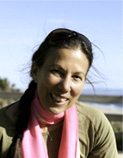My forays transforming wild game into palatable meals didn’t end with beaver. Each autumn, Bernard shot a Canada goose. Yes, these were the handsome, sometimes aggressive brown and black birds that wintered over on city reservoirs, colonizing the shore line, attacking intrusive baby carriages. I meditated on the Rombauer’s goose advice, but found it sorely lacking. They urged using a bird less than a year old. But how could I tell goose age, especially when there were hundreds of them pecking the stubble in our dry hay meadow? It’s not like geese presented themselves by age group or waving an ID card extracted from a down pocket. And then there was the hopelessly vague instruction to hang the bird for a period of 1 to 7 days. Even I knew that was a spread long enough to go from doorstop tough to maggot-filled. And they neglected completely to indicate where one should hang the bird and whether it should be defeathered and eviscerated beforehand, both of which seemed like essential bits of information if you didn’t want an unpleasant explosion on your hands. My infatuation with The Joy was being sorely tested. Goose-wise, it seemed the Rombauers were leaving us to fend for ourselves.
Source: google.com via Dina on Pinterest
The first year we hung the bird in the cool of our log storage shed. We left the feathers on, figuring a bit of flesh decomposition would make plucking easier. After 24 hours during which we checked the bird several times, we got unbearably skittish, neither of us wanting to be the one to discover the bird crawling with writhing white larvae. Bernard took the bird down and spent hours wrenching out feathers which were still attached to the skin as if clinging for dear life. I roasted the breasts with sliced apples, a la pheasant, using apple juice for basting. It emerged looking like a clod of baked mud. Unwilling to admit defeat, we sawed off a first bite and chewed for the next half hour, trying to soften the meat into something swallowable. The remainder of the meat we hacked into wedges which we left at the barn for the foxes.
Source: google.com via Dina on Pinterest
The following year, we let the goose hang for three days, and had an easier time extracting the feathers. I larded the breasts with bacon and thus we are able to eat three bites before agreeing to nourish the foxes once more. We also agreed that, assuming one of us could remember, we would hang next year’s goose for a week.
The third year’s goose brought back only unsavory memories, of how unrewarding it is to eat a badly prepared wild bird. With a barely perceptible nod, I discretely averted my eyes so Bernard could fling it, feathers and all, into the willows. My inner nascent pioneer woman assuaged her guilt by imagining the happiness of the next coyote who passed that way.
In the same years as we battled goose, we discovered elk. To our mutual delight and my own particular pride, Bernard was annually successful at bagging an elk, despite having set himself constraints that required him to ignore the herd that surrounded our house each morning and instead sit for hours in the woods near one of our north fields, hoping for the elk to cross in front of him over there. His success was only partially due to his using a rifle that Carlos the Jackal would be proud to own. He was a patient hunter and a scarily accurate shot. And he had me to answer to if he wounded an animal instead of killing it instantly.
Source: google.com via Dina on Pinterest
Not being to the hunt born, I invented my own “first day of hunting” ritual. I rose with Bernard at 4a.m. to fix him a light breakfast of toast, yogurt and espresso. He drover off into the pre-dawn chill, while I crawled back into bed and hoped that the phone wouldn’t ring. If it did, it’d mean Bernard had shot an elk on the first day of the season. Given the time he spent sighting in his rifle at the derelict gun range in town, where shredded paper targets flapped on the berms and spent shells glinted in the sunlight, crunching underfoot, not to mention days gathering hunting accoutrements like his camouflage outfit, his flaying knife and assorted other accessories, it would be a shame to have the hunting portion over so quickly.
If the elk won that first day, Bernard would get home an hour post-sunrise. After stripping off his layers of clothes, and allowing me to put my warm hands on his cold flushed face, we’d share a robust breakfast of eggs, salami, cheese, crusty bread, home made peach jam, fresh orange juice and more coffee.
Source: google.com via Dina on Pinterest
Eventually, Bernard would get so annoyed at having to get up early and wait for elk, that he’d shoot one. It was always a one-shot affair, clean through the head. Bernard wouldn’t have it any other way. In a nod to my feelings, Bernard always picked one which seemed to be without a calf. When he phoned to say that he’d be home late, because he had an elk to field dress, I waited impatiently to hear, “She was a dry cow. Nothing in her or on her.“ More often than not, he’d also give me some reassuring particulars, such as “She dropped right where she stood. And the funny thing is, none of the elk around her seemed to notice. They just went right on eating.” So much for the friendship and protection of the herd.
But what to do with the elk hide? Read on in Part Three!














